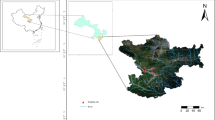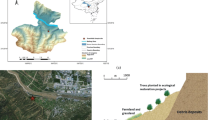Abstract
Vegetation is natural and environment-friendly material for slope reinforcement. To simple and effective analysis of vegetated slopes, a new method is proposed to consider the tensile strength cutting criterion (C–F criterion) of unsaturated root–soil composites. The proposed method incorporates the hydrological and mechanical effects of vegetation roots. A 1D stability model is developed to calculate the safety factors of vegetated slopes under steady transpiration state. Parametric studies are performed to investigate the effects of shrub root depth, slope angle, rainfall intensity, transpiration rate, and tensile strength on pore-water pressure (uw) and slope safety factors (Fs). uw and Fs are calculated using both the C–F criterion and the Fredlund strength criterion. The results demonstrate that Fs and uw decreases with increasing slope angle and rainfall intensity. Slope angle and rainfall intensity of vegetated slopes has a negative impacts on the slope stability. Moreover, Fs increases with increasing tensile strength. Furthermore, the transpiration rate and root depth increases, Fs and uw increases. Root depth, tensile strength, and transpiration rate are adverse for slope stability. Increasing slope angle and rainfall have detrimental effects on slope stability. Shallow slopes are more sensitive to rainfall than deep slopes. Fs for vegetated slopes with tensile strength cut-off are reduced compared to those based on the Fredlund strength equation. The C–F criterion is best suited for evaluating the shallow slope stability. Overall, the proposed method is a simple and practical approach to assess the vegetated slopes stability.












Similar content being viewed by others
Data availability
All data and models generated and used during the study appear in the submitted article.
References
Abd AH, Utili S (2017) Design of geosynthetic-reinforced slopes in cohesive backfills. Geotext Geomembr 45(6):627–641
Botero E, Ovando E, Mendoza MJ (2020) Successful prediction of slope failure in an excavation trial. Eng Fail Anal 109:104392
Chen JY, Fredlund DG (2003) Advance in research on shear strength of unsaturated soils. Rock Soil Mech 24(S2):655–660
Chirico GB, Borga M, Tarolli P, Rigon R, Preti F (2013) Role of vegetation on slope stability under transient unsaturated conditions. Procedia Environ Sci 19:932–941
Ciabatta L, Camici S, Brocca L, Ponziani F, Stelluti M, Berni N, Moramarco T (2016) Assessing the impact of climate-change scenarios on landslide occurrence in Umbria Region, Italy. J Hydrol 541(A):285–295
Cislaghi A, Bordoni M, Meisina C, Bischetti GB (2017) Soil reinforcement provided by the root system of grapevines: quantification and spatial variability. Ecol Eng 109:169–185
Cornforth DH (2016) Landslides in practice. Jouran of the Korean Society of Civil Engineers, 64
Das GK, Hazra B, Garg A, Ng CWW (2018) Stochastic hydro-mechanical stability of vegetated slopes: an integrated copula based framework. CATENA 160:124–133
Drucker DC, Prager W (1952) Soil mechanics and plastic analysis or limit design. Q Appl Math 10(2):157–165
Emadi-Tafti M, Ataie-Ashtiani B, Hosseini SM (2021) Integrated impacts of vegetation and soil type on slope stability: a case study of Kheyrud Forest, Iran. Ecol Model 446:109498
Fan CC, Lai YF (2013) Influence of the spatial layout of vegetation on the stability of slopes. Plant Soil 377(1–2):83–95
Feng S, Liu HW, Ng CWW (2020) Analytical analysis of the mechanical and hydrological effects of vegetation on shallow slope stability. Comput Geotech 118:103335
Fredlund DG, Morgenstern NR, Widger RA (1978) The shear strength of unsaturated soils. Can Geotech J 15(3):313–321
Ghestem M, Sidle RC, Stokes A (2011) The influence of plant root systems on subsurface flow: implications for slope stability. Bioscience 61(11):869–879
Greenwood JR, Norris JE, Wint J (2004) Assessing the contribution of vegetation to slope stability. Proc Inst Civ Eng Geotech Eng 157(4):199–207
Hales TC, Cole-Hawthorne C, Lovell L, Evans SL (2013) Assessing the accuracy of simple field based root strength measurements. Plant Soil 372(1–2):553–565
He Y, Liu Y, Hazarika H, Yuan R (2019) Stability analysis of seismic slopes with tensile strength cut-off. Comput Geotech 112:245–256
Khorsandiardebili N, Ghazavi M (2021) Static stability analysis of geocell-reinforced slopes. Geotext Geomembr 49(3):852–863
Leung T (2014) Native shrubs and trees as an integrated element in local slope upgrading. Ph. D. theses, Dept. of Civil Engineering, Univ. of Hong Kong
Leung AK, Ng CWW (2013) Analyses of groundwater flow and plant evapotranspiration in a vegetated soil slope. Can Geotech J 50(12):1204–1218
Leung AK, Garg A, Coo JL, Ng CWW, Hau BCH (2015) Effects of the roots of Cynodon dactylon and Schefflera heptaphylla on water infiltration rate and soil hydraulic conductivity. Hydrol Process 29(15):3342–3354
Li ZW, Yang XL (2019) Active earth pressure for retaining structures in cohesive backfills with tensile strength cut-off. Comput Geotech 110:242–250
Li MZ, Cai GQ, Li H, Yang BB, Zhao CG (2020) Stability of infinite unsaturated soil slopes with tensile strength cut-off. Chin J Geotech Eng 42(4):705–713
Liu HW, Feng S, Ng CWW (2016) Analytical analysis of hydraulic effect of vegetation on shallow slope stability with different root architectures. Comput Geotech 80:115–120
Lu N, Godt J (2008) Infinite slope stability under steady unsaturated seepage conditions. Water Resour Res 44(11):W11404
Lu N, Kim TH, Sture S, Likos WJ (2009) Tensile strength of unsaturated sand. J Eng Mech 135(12):1410–1419
Lynch J (1995) Root architecture and plant productivity. Plant Physiol 109(1):7–13
Masi EB, Segoni S, Tofani V (2021) Root reinforcement in slope stability models: a review. Geosciences 11(5):212
Michalowski RL (2018) Failure potential of infinite slopes in bonded soils with tensile strength cut-off. Can Geotech J 55(4):477–485
Michalowski RL, Utili S (2018) Discussion: stability of intact slopes with tensile strength cut-off. Géotechnique 69(12):1–15
Ng CWW (2017) Atmosphere-plant-soil interactions: theories and mechanisms. Chin J Geotech Eng 39(1):1–47
Ng CWW, Leung AK, Woon KX (2014) Effects of soil density on grass induced suction distributions in compacted soil subjected to rainfall. Can Geotech J 51(3):311–321
Ng CWW, Liu HW, Feng S (2015) Analytical solutions for calculating pore-water pressure in an infinite unsaturated slope with different root architectures. Can Geotech J 52(12):1981–1992
Ng CWW, Leung AK, Yu R, Kamchoom V (2017) Hydrological effects of live poles on transient seepage in an unsaturated soil slope: centrifuge and numerical study. J Geotech Geoenviron Eng 143(3):04016106
Park D, Michalowski RL (2017) Three-dimensional stability analysis of slopes in hard soil/soft rock with tensile strength cut-off. Eng Geol 229:73–84
Paul B (1961) A modification of the Coulomb–Mohr theory of fracture. J Appl Mech 28(2):259–268
Pollen N, Simon A (2005) Estimating the mechanical effects of riparian vegetation on stream bank stability using a fiber bundle model. Water Resources Research 41(7):W07025
Polyanin AD (2002) Linear partial differential equations for engineers and scientists. Chapman and Hall/CRC, Boca Raton
Rahardjo H, Satyanaga A, Wang C L, Wong JLH, Lim VH (2018) Effects of unsaturated properties on stability of slope covered with Caesalpinia crista in Singapore. Environ Geotech 1–11
Ratts PAC (1979) The distribution of the uptake water by plants: inference from hydraulic and salinity data. AGRIMED seminar on the movement of water and salts as function of the properties of soil under localized irrigation, held 6–9 November 1979 at Bologna, Italy
Rees SW, Ali N (2012) Tree induced soil suction and slope stability. Geomech Geoeng 7(2):103–113
Simon A, Collison AJC (2002) Quantifying the mechanical and hydrologic effects of riparian vegetation on streambank stability. Earth Surf Proc Land 27(5):527–546
Song X, Tan Y (2020) Experimental study on failure of temporary earthen slope triggered by intense rainfall. Eng Fail Anal 116:104718
Stokes A, Atger C, Bengough AG, Fourcaud T, Sidle RC (2009) Desirable plant root traits for protecting natural and engineered slopes against landslides. Plant Soil 324(1–2):1–30
Su X, Zhou Z, Liu J, Cao L, Liu J, Wang P (2021) Estimating slope stability by the root reinforcement mechanism of Artemisia sacrorum on the Loess Plateau of China. Ecol Model 44:109473
Tan H, Chen F, Chen J, Gao Y (2019) Direct shear tests of shear strength of soils reinforced by geomats and plant roots. Geotext Geomembr 47(6):780–791
Tosi M (2007) Root tensile strength relationships and their slope stability implications of three shrub species in the Northern Apennines (Italy). Geomorphology 87:268–283
Tsige D, Senadheera S, Talema A (2020) Stability analysis of plant-root-reinforced shallow slopes along mountainous road corridors based on numerical modeling. Geosciences 10:1–19
Utili S (2013) Investigation by limit analysis on the stability of slopes with cracks. Geotechnique 63(2):140–154
Vahedifard F, Leshchinsky D, Mortezaei K, Lu N (2016) Effective stress-based limit-equilibrium analysis for homogeneous unsaturated slopes. Int J Geomech 16(6):D4016003
Van Genuchten MT (1980) A closed-form equation for predicting the hydraulic conductivity of unsaturated soils1. Soil Sci Soc Am J 44(5):892–898
Waldron LJ (1977) The shear resistance of root-permeated homogeneous and stratified soil1. Soil Sci Soc Am J 41(5):843
Wu TH (1976) Investigations of landslides on Prince of Wales Island, Ohio State University, Department of Civil Engineering
Wu LZ, Zhang LM (2009) Analytical solution to 1D coupled water infiltration and deformation in unsaturated soils. Int J Numer Anal Methods Geomech 33(6):773–790
Wu LZ, Selvadurai APS, Zhang LM, Huang RQ, Huang J (2016) Poro-mechanical coupling influences on potential for rainfall-induced shallow landslides in unsaturated soils. Adv Water Resour 98:114–121
Wu LZ, Zhou Y, Sun P, Shi JS, Liu GG, Bai LY (2017) Laboratory characterization of rainfall-induced loess slope failure. CATENA 150:1–8
Wu LZ, Cheng P, Zhou JT, Li SH (2022) Analytical solution of rainfall infiltration for vegetated slope in unsaturated soils considering hydro-mechanical effects. CATENA 206:105548
Yin P, Vanapalli SK (2019) Corrigendum: model for predicting tensile strength of unsaturated cohesionless soils. Can Geotech J 56(1):153–153
Yuan FS, Lu ZM (2005) Analytical solutions for vertical flow in unsaturated, rooted soils with variable surface fluxes. Vadose Zone J 4(4):1210–1218
Zhai Q, Rahardjo H, Satyanaga A, Dai G (2020) Estimation of tensile strength of sandy soil from soil–water characteristic curve. Acta Geotech 15(12):3371–3381
Zhang C, Zhou X, Jiang J, Wei Y, Ma J, Hallett PD (2019) Root moisture content influence on root tensile tests of herbaceous plants. CATENA 172:140–147
Zhu H, Zhang L (2019) Root–soil–water hydrological interaction and its impact on slope stability. Georisk Assess Manag Risk Eng Syst Geohazard 13(4):349–359
Zhu SR, Wu LZ, Huang J (2022) Application of an improved P(m)-SOR iteration method for flow in partially saturated soils. Comput Geosci 26(1):131–145
Funding
This work was supported by the National Natural Science Foundation of China (No. 42277183), the Chongqing Natural Science Innovation and Development Foundation (No. CSTB2022NSCQ-LZX0044), the Chengdu University of Technology Postgraduate Innovative Cultivation Program (No. CDUT2023BJCX006).
Author information
Authors and Affiliations
Contributions
PC: writing—original draft, conceptualization, methodology, and software. LW: writing—review and editing, methodology, supervision. HZ: software and investigation. JZ: methodology, conceptualization, and validation.
Corresponding author
Ethics declarations
Conflict of interest
The authors declare that they have no known competing financial interests or personal relationships that could have appeared to influence the work reported in this paper.
Additional information
Publisher's Note
Springer Nature remains neutral with regard to jurisdictional claims in published maps and institutional affiliations.
Rights and permissions
Springer Nature or its licensor (e.g. a society or other partner) holds exclusive rights to this article under a publishing agreement with the author(s) or other rightsholder(s); author self-archiving of the accepted manuscript version of this article is solely governed by the terms of such publishing agreement and applicable law.
About this article
Cite this article
Cheng, P., Wu, L., Zhang, H. et al. Stability analysis of vegetated slopes under steady transpiration state considering tensile strength cut-off. Environ Earth Sci 83, 207 (2024). https://doi.org/10.1007/s12665-024-11444-1
Received:
Accepted:
Published:
DOI: https://doi.org/10.1007/s12665-024-11444-1




